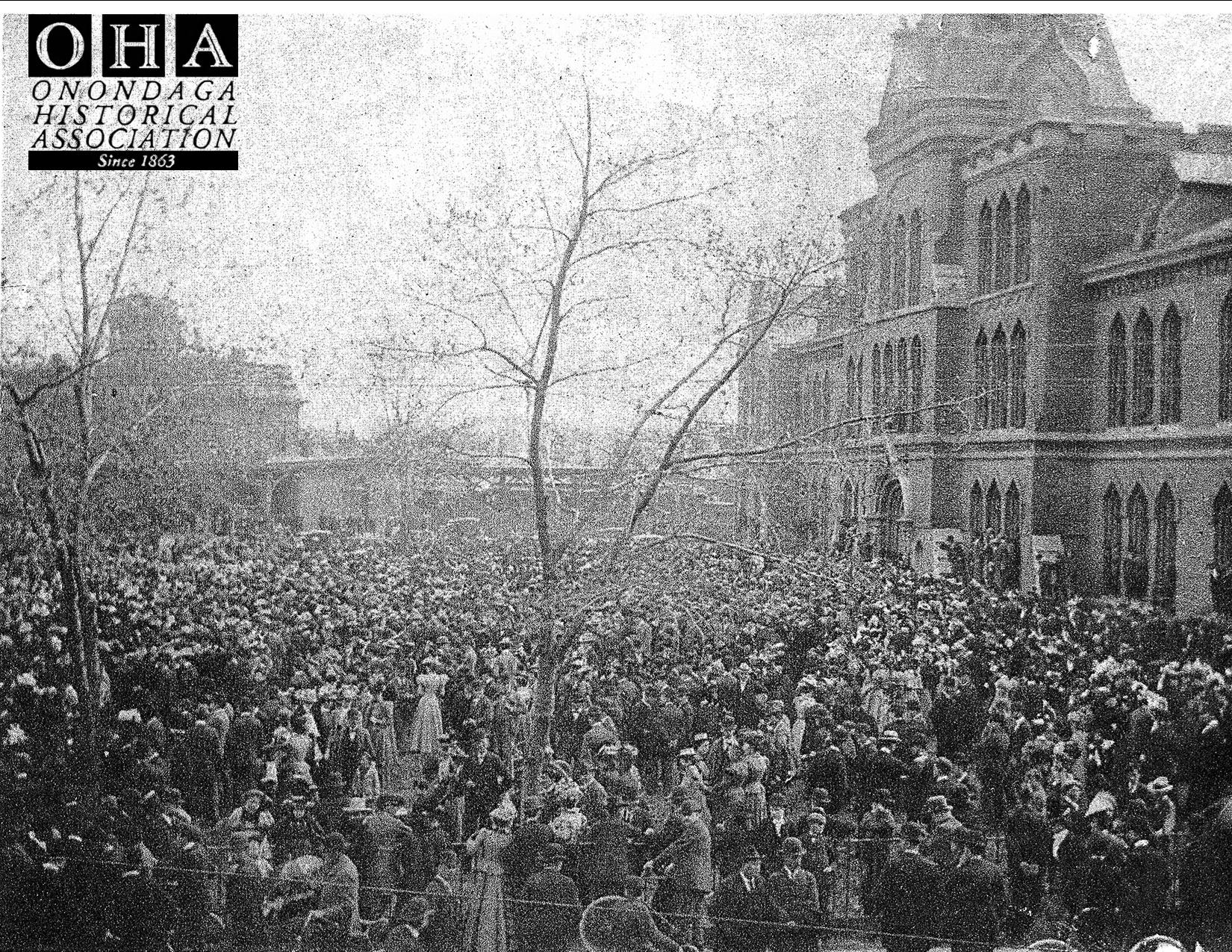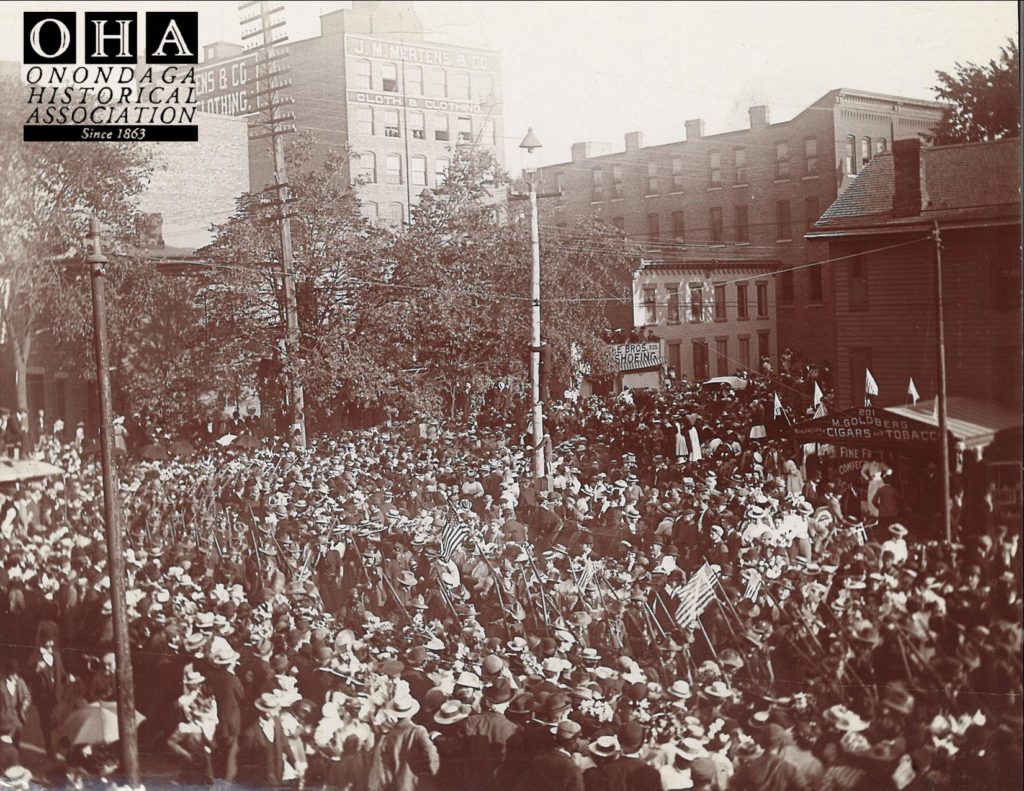
When the Spanish-America War began in April 1898, President William McKinley called for volunteers, including the National Guard, to augment the U.S. Army. The 41st Separate Company, a Guard unit based in Syracuse, was nationalized to become Co. C, 2nd Battalion, 3rd Infantry Regiment, New York. Commander of the 41st, Captain John G. Butler, was the former commander of Butler’s Zouaves during the Civil War.
On Sunday, May 1, 1898, the men gathered in the State Armory to say goodbye to their families, as many tears flowed. Among the volunteers was Reuben Thurwachter, a 26 year old city resident who sold willow baskets in his father’s store. He was a handsome young man, quite the dancer and archery expert. After protecting the home front for several years, and like many other young men in the company, Private Thurwachter was ready to go to war.
The men marched to the New York Central Railroad Station, the crowd cheering as they left the Armory. The next day, the 41st arrived at Camp Black on Long Island, and on May 16th, was mustered into U.S. Service. In late May the regiment traveled to Camp Alger near Falls Church, Virginia, where on Memorial Day, the 3rd NY and the 3rd Missouri held a memorial service for their respective comrades who fell in that area during the Civil War. On June 27th, Company C received a flag presented by the people of Syracuse. Private Thurwachter was promoted to Corporal on July 8th.
Throughout August, the 3rd NY trained and camped throughout Virginia, and Corporal Thurwachter was promoted to Quarter Master Sergeant. They waited for their big call to go invade Cuba, but that call never came. The war lasted only four months, the U.S. easily defeating Spain by mid August. On September 12th, the Company was back in Syracuse.

Although the 41st Separate Company didn’t leave the country, Syracusans still celebrated them as heroes. They paraded to the Armory, enjoyed a delicious dinner, and were formally welcomed home by Mayor McGuire. They received 30-day furloughs and then mustered out of U.S. service. Reuben Thurwachter lived the rest of his life in Syracuse, yachting and ice boating on Onondaga Lake, and promoting archery. He married Inez Hildreth in 1922 and died at 88 in 1959.
There were still several military officers who served during the Spanish-American War who hailed from Syracuse. Major General Samuel Storrow Sumner and Brigadier General Edwin Vose Sumner, Jr., two sons of Civil War General Edwin Vose Sumner, also veterans of the Civil War, fought again during the Spanish-American War. Edwin, Jr., the older of the two sons, was appointed a brigadier general of volunteers at the beginning of the Spanish-American War and then appointed brigadier general in the U.S. Army in March 1899. Three days later, he retired from military service after serving for thirty-seven years. Edwin’s younger brother, Samuel, after serving during the Civil War, was appointed a major general of volunteers during the Spanish-American War. Samuel fought at the Battle of San Juan and at the siege of Santiago. After the Spanish-American War, Samuel served in the U.S. Army during the Boxer Rebellion in China (1899-1901) and the Philippine-American War (1899-1902).
Captain John G. Butler, who commanded a company of Zouaves during the Civil War, commanded the 41st Separate Company, which became Company C, Third New York Volunteers.
Lieutenant Malvern Hill Barnum was the son of Colonel Henry Barnum, commander of the 149th (Fourth Onondaga) Infantry Regiment during the Civil War. Barnum’s father named him Malvern Hill after the Civil War battle in which his father was severely wounded. Barnum graduated from West Point in 1886 and served with the U.S. Cavalry. During the Spanish-American War, Barnum was wounded at the Battle of San Juan and was awarded the Purple Heart. As a career army officer, Barnum was promoted to the rank of brigadier general in 1917 and commanded the 183rd Infantry Brigade in France during World War I.
Other Syracusans saw naval action with Commodore Dewey in the Philippines and with Rear Admiral William Sampson in Santiago de Cuba Bay; experienced combat in the invasion of Cuba in the Fifth Army Corps commanded by Major General William Shafter; and still other Syracusans served with Ninth U.S. Infantry and with cavalry regiments.
Reports mention twenty-four year old Private Gustave Kolbe, Troop K, First U.S. Cavalry, was killed by enemy bullets at the Battle of Las Guasimas during the Santiago Campaign on June 24, 1898. He was the first Syracusan to be killed in the Spanish-American War. Kolbe was a German immigrant, moving from Hamburg to Syracuse when he was nine years old.

